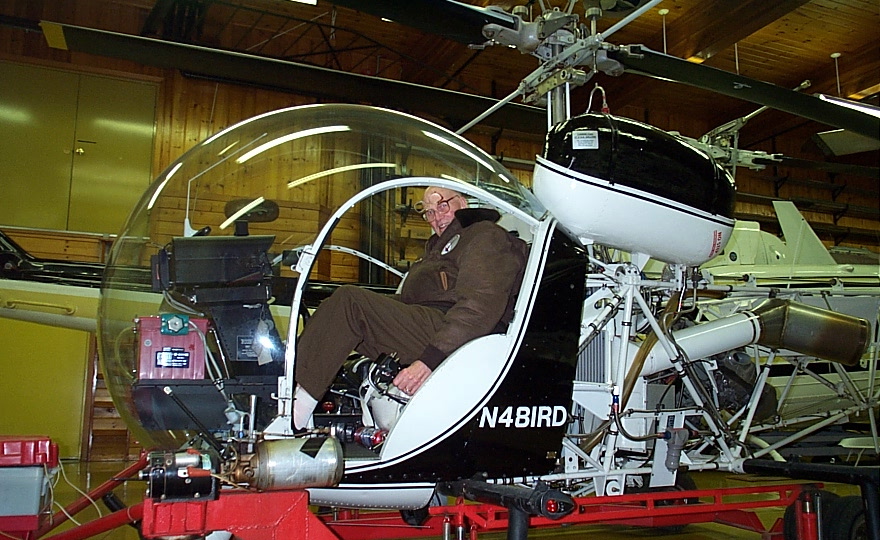Recently, while looking around a collection of hangars in northern Idaho, containing 18 helicopters and fixed wing aircraft, it became evident that Doctor Forrest M. Bird could say his life truly mimics his name.

Dr. Forrest M. Bird, shown in his 1968 Bell 47 (G3B-2), was inducted into the National Inventors Hall of Fame in 1995, for his unique fluid dynamics. His aviation activities are his “medical escape.”
Bird, who resides in Sandpoint, Idaho, was inducted into the National Inventors Hall of Fame in 1995, for his unique fluid dynamics, which he employed in the invention of cardiopulmonary medical respirators.
Born in Stoughton, Mass., on June 9, 1921, Bird introduced the world’s first reliable low cost, mass produced respirator in 1958. Over the ensuing years, other Bird respirators were introduced, such as the Babybird, which reduced the death rate in low birthweight babies with respiratory problems from about 70 percent down to less than 10 percent, within a two-year period.
During the nineties, Dr. Bird introduced an advanced fourth generation of cardiopulmonary devices employing a novel concept called Intrapulmonary Percussive Ventilation (IPV)). This concept has reduced deaths among severely burned patients with chemical inhalation injuries, from over 60 percent down to between 10 and 15 percent. Additionally, his state-of-the-art breathing machines continue to save thousands of critical care patients, the world over. The respirators not only save lives, but also improve the quality of life in thousands of home patients with advanced heart and lung disease.
Bird, possessing a mechanical aptitude, was innovative from his boyhood, first designing and making homemade tractors from Model T Fords, to restoring aircraft, and then in advancing technology in medicine.
|
His father, who began learning how to fly in St. Louis at a Curtiss Wright Flying School, just before World War I, enlisted in the Army Air Corps just before America entered the war. He was then sent to ground school at MIT and an Army flying school in upstate New York, before being sent to Kelley Field in Texas. Sent to France with the American Expeditionary Forces as a pilot, during WWI, Captain Bird was one of the first American pilots to fly early bombers over German soil.
After WWI, he returned to Stoughton, and resumed his designing of lasts (a shoemaker’s mold) for shoes. In order to keep flying, he served in the Massachusetts Air Guard reserve, flying out of East Boston Airport. |

Dr. Bird’s inventions include the Babybird and the fourth generation VDR (Volumetric Diffusive Respiration) Percussionator ventilator, shown above.
In 1928, he purchased a GXE Waco 10 with a Curtiss 90-hp OX5 water-cooled engine. In the open biplane, with two side-by-side seats in the front cockpit, the pilot occupied a back cockpit. It was in this airplane, flying with his dad, that Forrest Bird became possessed with flying.
In 1935, at the age of 14, he was soloed by his dad in the family Waco. Typically, the GXE Waco didn’t have brakes or a tailwheel, using a steel tailskid with rudder and elevators for directional control. Growing up in the Waco served to fascinate young Bird with anything to do with airplanes.
He obtained a job as a line boy at Canton Airport (after school) located near Boston, where many millionaires and their sons had magnificent airplanes of all types. Soon, he had made friends with many of the owners by keeping their airplanes spotless; this led to their allowing him to fly with them, further launching a life centered on aviation.
By 1937, the Waco needed a complete restoration. This became a family project between young Bird’s grandfather, who was an excellent woodworker, his dad, who enjoyed working on his aircraft, and a close WWI friend, Roy Keeley, an early CAA inspector. It was also a great learning experience for young Bird, leading toward an aircraft mechanics aircraft and engine license.
Soon, the magnificent yellow Waco GXE (NC901H), with a hand-rubbed finish, was admired at all the New England airports visited by Forrest Bird and his dad. With access to the Waco and many of the finest of aircraft, as well as flight instruction in exchange for work, Forrest Bird was soon on his way toward a commercial pilots license with an instructors rating. In the years leading up to WWII, he became a very experienced pilot for his age, with an academic background in aeronautics, along with an ROTC reserve commission, which prepared him for entry into the Army Air Corps as a technical air training officer in the Air Transport Command, flying the latest military aircraft.
Getting to this point in his history, Dr. Bird regresses to some of the cardinal points in what he calls a life of “Fate, Time and Circumstance.”
“One cannot control when and to whom one is born, at what geographical location and/or the existing economic environment,” he said.

Dr. Bird’s inventions include the Babybird and the fourth generation VDR (Volumetric Diffusive Respiration) Percussionator ventilator, shown above.
Growing up on a 250-acre gentleman’s farm in New England during the depression of the thirties, with a well-educated mother and father, young Bird had many advantages. However, his father advised him early on that although he would provide him with a good home and necessities of life, the rest would have to be earned.
Forrest Bird went to a private kindergarten and then on to public schools. Living in a rural area, he started school in a five-grade, single-room schoolhouse. By the time he was six, secondary to tutoring from his mother as well as his dad, he could read and write at a third-grade level. He started school in the second grade; during his first school year, he listened to what went on in the third grade row and was allowed to skip that grade; likewise, he skipped the fifth grade. Now three grades ahead for his age, it was fortunate he was a “tall beanpole,” maturing to over six feet four inches by the age of 16.
With European unrest and increasing U.S. involvement, it was considered a matter of time before an all out war could occur. In an effort to advance mechanical aptitudes in young high school students, a very limited special Mass Educational (Mass Ed) academic program was advanced in the mid-thirties. This served to take young men with high academic standards and accelerate their last two years of high school, centered on the sciences and military discipline, with an early entrance into advanced college engineering type studies.
Bird spent his last years of high school at the Brockton Armory in special advanced classes of mathematics and physics. His college program centered on aeronautics involving mechanical engineering and physics. As a component of his formal education, the fourth year of college was directed toward receiving on-the-job training with one of three participating airlines. That was to result in an airline transport rating. However, because of the ROTC reserve status and the increasing military involvement in the airlines, Military Transport Training Divisions were created. Here again, Bird was accelerated because of his advanced knowledge, into the first MTD class at Eastern Airlines in Atlanta.
The WWII Years
Just after receiving his ATR, Bird was called to active duty, on Dec. 8, 1941. Assigned to the fledgling Army Air Transport Command, he was first sent to Buffalo, N.Y., for training in the Curtiss Commando C-46 transport aircraft. Upon his completion, he was sent to Morrison Field (West Palm, Fla.), where he started to fly from there to Belem, Brazil, and then down to Natal with cargo. He would bring back latex rubber balls from Belem from an Amazon supply of natural rubber trees.
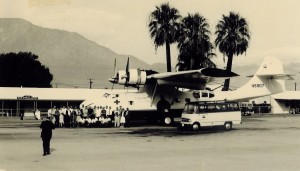
In the 1960s, Dr. Bird converted a PBY amphibian to a four-engine airplane, with intercontinental fuel range. Shown at Palm Springs Airport, the “Bird Innovator” was set up as an air evac transport.
His next assignment was the central instructors school at Kelley Field, where he checked out in Martin B-26s, A-20s, B-25s, B-18s and a number of other aircraft.
From Kelley, he was sent to the Navy water school at Pensacola, where he checked out in N3Ns on floats, Grumman Ducks, Widgeons and Geese and PBY flying boats. From there, he was sent to Long Beach, Calif., where the sixth ferry base was being established, and where the nation’s first ILS (instrument landing system), on runway 30, would later be installed.
He soon became the technical air training officer, establishing the ground training, which included the preparation of pilot flight manuals for each military aircraft, as they were introduced into service.
Bird was able to prepare for his training manual preparation by ferrying (delivering) new model aircraft from the factories to various war zones. Early on, Bird became a class 5P pilot, which meant he was qualified in all military aircraft, including trainers, fighters, observation, bombers and transports.
“I should have paid them; it was fantastic,” he said.
Bird’s wartime ferrying would include flying Commandos and the early C-54 over the Hump, and the experience of flying B-25 Mitchell bombers, specially equipped H models, the only aircraft at that time set up with state-of-the-art ILS, to Hastings in southern England, for an assignment that involved strikes on locomotives in May and early June of 1944.
At that time, the temporary airfield at Hastings was the only one in Europe that was all weather with an ILS; it had a steel mat runway set up with full ILS. Given P-47 fighter drivers as copilots, Bird and the other pilots were tasked with working up the railroad tracks along the French coast. Unlike the P-47 pilots, who had been going in perpendicular to blast the locomotives, they would now strike head-on.
“The Germans had put 50-caliber guns in their coal cars behind the engines, and were knocking these guys out of the air,” said Bird.
The B-25s they were flying were equipped with a manual-loading recoil-less French 75 canon in the nose, as well as 50 and 30 caliber machine guns. To interrupt small arms fire, the bombers had armor-plated bellies.

This 1938 Piper J3C-65 (N26044) once belonged to Dr. Bird’s father. Bird Space Technology has rebuilt the aircraft twice.
“If an engine was coming towards us, we’d fire the French 75 right into the boiler,” Bird said. “Most of the time, we’d work inland, probably up to 150 miles, and then we’d come out over Dunkirk. If anyone were after us, we’d pull up in the clouds. Then we’d go back home to the ILS.”
On one particular day when at least three locomotives had been hit, Bird recalls it being “busy as hell” and the best weather they had to date. He also recalls that over Dunkirk, his ship took small arms fire, but was still flyable. Returning and crossing the Channel, he noted an increase in air and small boat traffic. He would later find out it had been to mislead the Germans regarding the Normandy invasion.
“We went back and landed, and people came running up, saying, ‘Tell us about the invasion,'” he said. “We didn’t know about the invasion at the time we went in, but, of course, it was the invasion.”
The locomotive endeavor, he said, was very effective.
“We had 15 airplanes and probably got 30 to 40 locomotives, and we only lost one airplane,” he said. “The Germans had been getting maybe one out of five P-47s.”
Up until that period, most of his flights were across the North Atlantic, starting with Lockheed Hudson Bombers, then into the four-engine B-17s and B-24s.
Bird was one of the first Army helicopter pilots checked out in the Sikorsky R-4 with a 165-hp Warner engine. Additionally, he flew the Bell Aircomet P-59 (the first U.S. military jet).
A Captured German Aircraft Leads To First Invention
On one of his European B-17 deliveries to Europe, he received orders to ferry a captured German Junkers Ju-88 from the British RAF back to the states for study. This was to have a major impact on Bird’s future. Aboard the special high altitude version of the Ju-88 was an advanced demand oxygen breathing system. U.S. aircraft were still using the A3A free flow oxygen system, into a BLB facemask. This restricted airmen to 28,000 feet, because of the inability of the free flow oxygen systems to maintain adequate arterial oxygen, a major limitation since the P-38s, B-17s and B-24s had Minneapolis Honeywell Turbochargers, allowing the aircraft to fly above 30,000 feet.
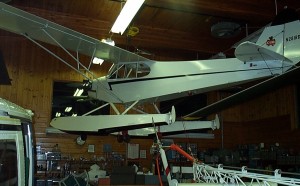
One of two 1938 Piper J3C-65s owned by Dr. Bird, this one (on Edo straight floats) made the first flights using “Smartplugs” catalytic ignition system instead of electrical engine ignition.
During the flight across the North Atlantic from Preswick, Scotland, Iceland, Greenland and Labrador, and on to Ohio, Bird became well acquainted with the German demand oxygen system. It fascinated him to the point where he removed the aft system and carried it back to Long Beach with him.
The basic problem Bird discovered with the German demand regulator was that the “work of breathing” to release the oxygen during spontaneous breathing was excessive. Bird set out to redesign it. With the help of his flight surgeon, he ended up with an advanced pressure breathing system employing revamped Mine Safety Appliance Gas Masks, etc.
In order to test his new pressure demand system, he first used the chambers at March Field, but they only went to 25,000 feet. This led to using B-17s and B-24s to climb to altitudes above 30,000 feet.
“We would start out at 10,000 feet and write our names on paper, then up to increments of 5,000 feet then back to 10,000 feet,” Dr. Bird said. “If we were hypoxic, our writing would become increasingly less legible. Soon, we were going to 35,000 feet, with perfectly legible handwriting, which proved we were not hypoxic.”
It was a major accomplishment, and obviously, they were excited, but what would they do with their discoveries? The answer came from Dr. Hulsey, a retired internist over 60 years of age. By that time, he had been to the Navy Submarine School of Medicine at New London and the Army School of Aviation Medicine at Randolph Field.
“He suggested I visit Dr. Armstrong at the School of Aviation Medicine and report what we had done directly to him,” Dr. Bird said.
Because of military protocols, this would have to be unannounced.
“One morning I received orders to ferry a P-51 to Newark, N.J.,” he said. “That morning the weather on the northern route was not good. This gave me an excuse to fly the southern route through San Antonio.”
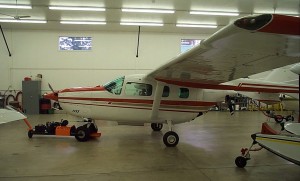
Modifications of this “push-pull” 1979 Cessna T337H Skymaster (N181RD) include upgraded instrumentation and avionics, Horton STOL, aerodynamic spoilers, Flint wingtip fuel tanks and large-area empennage fairings.
Bird arrived at Randolph Field early in the morning and boldly went unannounced to Dr. Armstrong’s office. He was greeted by, “What you have to say must be very important to arrive in my office under these pretenses.”
“I then briefly explained what we had done and showed a prototype to him,” Bird said. “Then, he asked me how I tested the device, and I told him about our B-17 and B-24 revelations. He remarked that either I was a damn fool or I knew something he did not. My reply was, ‘Probably a little bit of both, Sir.'”
Over the next few hours, Dr. Armstrong called in several of his visiting consultants, including two noted physicians, Dr. Cournand and Dr. Barach, who were very knowledgeable in these areas.
During the revelations, Dr. Armstrong, after setting up and breathing on the regulator, said, “This is nothing but a demand breathing regulator–but a damn good one.”
“I then advised him I had an aneroid in the device that would progressively start pressure breathing over 25,000 feet,” Bird said. “Then, I had an interesting visit with Dr. Cournand, who suggested I enter into biomedicine as he had done; he described human physiology (how the body works) as God’s engineering in the body.”
Bird’s reply was that he was a “flyboy,” and most likely would either stay in the military or return to an offered position with Eastern Airlines.
“After my revelations at Randolph, I flew up to Newark with my P-51, arriving in the wee hours of the morning,” he said. “That afternoon, I was on my way from Republic to Oakland, Calif., with a new P-47.”
Some weeks later, Bird received a number of test books on physiology, which spiked a lifelong learning experience on the subject. Over the next few months, his Randolph visit and his pressure/demand regulator faded away, as he continued his normal activities.

This 1980 Cessna TU206G (N98IRD) on Edo 3500 amphibious floats has modifications including a Soloy Conversions Allison 250-C20 turboshaft engine installation and STOL modifications.
“Then, Dr. Hulsey and I received orders for TDY (temporary duty travel) at the School of Aviation Medicine,” Bird said. “Upon arrival, much to my surprise, I found that our crude prototype had been advanced into a highly efficient pressure/demand breathing system with a wonderful fitting mask. Obviously, we were very pleased. Within a few months, the updated regulator was produced by Bendix and Aero, increasing human altitude to tolerances under combat conditions.”
After the allied invasion of the European continent, Bird’s duties shifted into the Pacific. For months to come, he picked up B-24s at Fairfield Suisan Airfield (now Travis) and ferried them through Honolulu, to Christmas and Canton islands, and then on to Brisbane, Australia.
“After delivery, we would be flown back to San Diego, retracing our route aboard Consair (Consolidated) Airlines, in modified B-24s called C-87 transports,” Bird said. “We would sleep in sleeping bags most of the way back. Within several days, we would repeat our crossing.”
He delivered many B-24s before starting on B-29s.
“The early B-29s had major engine cooling problems on their massive 3350 Wright engines,” Bird said. “I learned to change my own cylinders, carrying spares on board. Gradually, factory technicians and spares were at our fuel stops and they would repair our aircraft as we rested.”
After WWII
Dr. Bird recalls the day the Japanese surrounded. He was in Brisbane with a C-54, flying back to the U.S. with a load of returning soldiers.
“We arrived off the Golden Gate Bridge early on a beautiful clear Sunday morning on the way into Fairfield,” he said. “I decided to fly under the Golden Gate Bridge as countless Navy pilots out of Alameda Naval Air Station had done before me.” As they flew under the bridge, he announced, “Welcome home,” to his half-asleep passengers.
After WWII, Bird elected to remain in the Air Force, after a lengthy permissive leave of absence, during which he was able to build up a substantial “nest egg.”
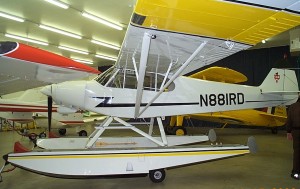
Modifications on Dr. Bird’s 1981 Piper PA-18-150 Supercub (N88IRD) include installation of a 180-hp Lycoming O-360 engine and Wipaire 2100 amphibious floats.
“During my military leave, I entered into a business of selling and modifying transport aircraft, mostly C-47s and C-54s, and Grumman Geese amphibians, for overseas airlines and civilians,” he said. “I would use veterans priorities to bid on C-47s and C-54s ahead of the foreign air carriers. I would then modify the aircraft in a hangar on the Long Beach Airport, employing ‘moonlighting’ Air Force sub depot employees.”
At one time, he purchased 48 P-38 M and L model surplus aircraft from Kingman, Ariz., for $1,250 each, since they had the first APN-4 four channel VHF transceivers.
“I sold the APN-4s for $2,500 to the foreign airlines and the P-38s as low as $300 each,” he said. “How would you like to have those today? Also, I purchased three P-63Fs for $900 each, which had the APN-4s. I kept one of these for several years. It was a great low altitude performer when compared to the P-51.”
After returning to the new Air Force, Bird was first sent to Carswell for B-36 transition, which was a great learning experience. His next assignment was aerial refueling at Boeing in Wichita, which he found fascinating. Finally, it was settling down to B-36 Russian perimeter flights out of March Field, up through Alaska and returning, which amounted to a 33-hour duty flight with ample time off between flights.
The Development Of A Pilots Anti G System
As turbine aircraft were coming into inventory, the jet fighters could pull ever-increasing loads, but black outs were of increasing concern.
“It amounted to having equal aircraft and pilots with the variance being the time of useful consciousness, which could determine the winner,” he said.
Bird set out to develop a pilots anti g system.
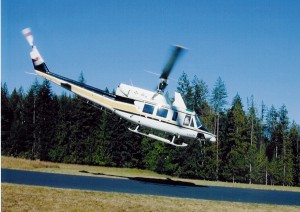
Dr. Bird’s 1977 Bell IFR 212 (N38IRD) has been an important testbed in his pioneering aeromedical research.
“Dr. Hall at Duke University had earlier made a practical pressure suit, but it did not address anti g considerations,” Bird said. “I developed a foot-to-chest suit having three chambers, one for the calves of the legs, the next for the thighs and the other for the stomach area below the naval. I developed a magnetically controlled regulator that would respond to a calibrated g load. As the valve opened, it would progressively pressurize the suit with compressed nitrogen, starting at the calves and finally the abdominal areas, which effectively prevented blood from draining away from the cerebral circulations. Thus, a 4 g load could be reduced to about a 2 g load. This simple but effective system became the forerunner of anti g suit systems.”
In the process of testing his anti g suit system, Bird was injured during the evaluation on a centrifuge, when a seat failed during a positive g load, near instantaneously going to a negative high g sustained pressure upon his cerebral circulation. He suffered hemorrhages in his eyes, which blinded him then as well as causing continued loss of sight that would gradually return.
“I saw my life go up in smoke,” he said.
Bird was removed from flight status during a long period of time, in which he obtained a medical education.
“I became associated with human factors at Muroc (Edwards),” he said.
That education, said Dr. Bird, was not acquired because he wanted to “hang up a shingle and practice medicine,” but because he simply “wanted to learn medicine and have the same education as a physician–and better.”
Bird was not back on flight status until near the end of the Korean War, and then assigned to transport only, mostly C-124s from Travis, to Clark Field in the Philippines, flying wounded soldiers home. This introduced him to air evacuation, and the realization that there was a need for a breathing machine to breath for patients with chest and lung injuries.
“This new air evacuation interest led toward developing a medical respirator,” he said. “Little did I realize that the magnetic clutches I had developed in the pressure suit regulator would serve as the basis of an efficient universal medical respirator.”

Dr. Bird’s 1940 Boeing B75N1 Stearman (N2803D) was restored in 1990 and is powered by a Pratt & Whitney R-985 engine. Other modifications include enclosed canopy, a smoke system and updated instrumentation and avionics.
By the time the Vietnam War had started, Dr. Bird had a low cost universal “cradle-to-the-grave” medical respirator, Bird(r) Mark 10, in about every hospital in the world.
Dr. Bird’s work in this field would be partially motivated by a personal factor. Following WWII, he married. His wife Mary was a triplet, all of whom suffered from emphysema and died relatively early of pulmonary disease. (Mary lived until 1986).
For his prototype respirator, he converted his pressure suit regulator by “turning it in a different position and modifying it.”
“That became the Mark 7,” he said.
The earlier respirators sold for $375, a price every hospital could afford.
During the Vietnam War, Dr. Bird started air evacuation with helicopters equipped with intensive care transport facilities, using the respirators. No longer was the transporting vehicle just a traveling bed.
“We could actually stabilize patients in flight,” he said.
Bird Corporation and Bird Space Technology
After the Vietnam War, many active Air Force soldiers were offered a type of active reserve outside of the National Guard with reduced duty times.
“This I selected, which allowed me to spend increasing time in furthering my cardiopulmonary developments,” he said. “I still was able to keep up my flying. In fact, I had flown about all the century series of aircraft before my military flying was over.”
In the sixties, Bird had converted a PBY amphibian to a four-engine airplane, with intercontinental fuel range. The aircraft was set up as an air evac transport for up to seven paralyzed patients, becoming the matrix for future military transports used for air evac such as the DC-9 “Nightingale,” etc.

The North American AT-6 (NC901H) is mostly original, except for a few modifications required to obtain a civil airworthiness certificate, and installation of modern instrumentation and avionics.
“I flew this airplane around the world for over 25 years for both military and civil teaching of air evacuation procedures,” Bird said. “Interestingly, during the Cold War, the Russians and Chinese were among those military and civil institutions using my respirators.”
By 1978, Dr. Bird had created a major medical organization, Bird Corporation, which he totally owned, debt free. He merged the Palm Springs-based organization into the 3M Company on Jan. 11, 1978, but retained Bird Space Technology, which remains his aeromedical research division. Over the next few years, he gradually relocated his R&D facilities to his expanding Idaho facilities, some 50 miles below the Canadian border on Lake Pend Oreille.
His fourth generation of cardiopulmonary devices has taken over a decade to prove themselves, and is now a major component of cardiopulmonary medicine.
An Award For Success
During the nineties, Dr. Bird built up a unique non-commercial aircraft operation around an airfield on his ranch, which is surrounded by “some of the world’s most spectacular scenery.”
“This has been my medical escape,” he said. “When I look back on my life, I realize that without my aeronautical qualifications, I could not have excelled in my various pursuits. The time spent on aviation projects has always been my reward for succeeding in my medical projects.”
The pilot has about 20,000 combined flying hours, with about 5,000 military and 1,000 airline. He also has more airplanes than most. When asked what he does with them all, he has a simple answer.
“I fly them one at a time,” he says, adding that he uses “airplanes like most people use automobiles.”
And, he isn’t the only Bird that flies them. His wife, Pamela Riddle Bird, who founded and is president and CEO of Innovative Product Technologies, and who is constantly on the look out for patent-worthy consumer products, flies a little. His daughter Catherine also flies.

This 1974 Bell 206B (N581RD) JetRanger has been modified to the configuration of a 206BIII and outfitted as a critical care transport ship.
A member of the Flying Physicians and Quiet Birdmen, Bird also enjoys taking up visiting retired physicians and military pilots, besides using various aircraft for search and rescue efforts and to give bi-annuals.
As evidenced, he doesn’t like to leave “well enough” alone. There doesn’t seem to be an airplane in his stable that he hasn’t modified to some extent, such as a 1940 Boeing Stearman, 1979 Cessna Skymaster and 1956 de Havilland Chipmunk.
Bird’s helicopters include his 1968 Be11 47 and 1974 Bell 206B JetRanger, which has been modified to the configuration of a 206BIII, primarily by installation of a 250-C20B engine, and has been outfitted as a critical care transport ship. Bird also has a 1977 Bell IFR 212 (N38IRD), which, with under 600 hours total time in service, is “undoubtedly among the cleanest and lowest-time 212s in existence.” It has been an important testbed in Bird’s pioneering aeromedical research, and has enough soundproofing that “a stethoscope can be used during the flight.” It’s equipped for single-pilot IFR operation.
All of Bird’s helicopters have been used in fire prevention, and, speaking of fires, Bird also has his own fire trucks.
“We’re way out here in the woods,” he explains.
Unlike most of Bird’s aircraft, his 1993 model American Champion 8KCAB “Decathlon” (N267R) is largely unmodified, except for the installation of a second airspeed indicator, visible from the rear seat in order to facilitate dual instruction, and a glider tow system.
As for his 1958 Grob G-109B (N113DB) motorglider, it’s rumored that Bird tends to forget to come home early when he’s spending time in the craft of all-composite construction, with a Volkswagen engine and composite propeller.
Then, Bird has two Alon A-2s, one (N21DB) of 1967 vintage has modifications including extra fuel capacity and folding wings. Completely restored in 1991, it can be trailered with the wings folded, and can be set up for flight in just a few minutes. Unlike the early Ercoupes from which it evolved, it has independent three-axis flight controls and yields performance numbers comparable to airplanes of much greater horsepower, while retaining its docile handling qualities. A 1965 model (N103DB) completely restored in 1988 is equipped with a 150-hp Lycoming engine, fuselage fuel tank, digital engine instrumentation and Unison Industries Lasar ignition system.
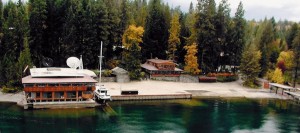
Dr. Bird holds seminar at the Bird AirLodge, in Idaho, which has facilities for housing seminar attendees. His house is shown to the right. His helicopter hangar is adjacent to the lodge.
Bird also has a 1972 Schweizer SGS-2-333A (N1179S) sailplane, 1947 Republic RC-7 “Sea Bee” (N781RD) and a Cessna 421C, which is the flagship of his fixed-wing fleet. It has been highly modified for cross-country use.
“I can go anywhere with it,” Bird said. It’s faster than my King Air 200 was.”
Visiting one of four hangars, you’ll see a 1980 Cessna TU206G (N98IRD), North American AT-6 (NC901H), 1981 Piper PA-18-150 Supercub (N88IRD) and the 1938 Piper J3C-65 (N26044) that once belonged to his father. It was in that airplane that Bird received his first commercial test flight and his CAA instructors rating. Bird Space Technology has rebuilt the aircraft twice.
Bird says he’s soloed about 50 people in it, including his daughter Catherine, who received her first FAA rating in it, in the mid-sixties. She also has an instructor rating.

Dr. Bird’s unique non-commercial aircraft operation around an airfield on his ranch is surrounded by spectacular scenery. Eighteen helicopters and fixed wing aircraft are housed in four hangars on the property in northern Idaho.
Bird also has a second Piper Cub ((N28IRD), which is on Edo straight floats. It spends the summer on Lake Pend Oreille and the winter suspended from the ceiling in Bird’s helicopter hangar, and made the first flights using “Smartplugs” catalytic ignition system instead of electrical engine ignition.
Besides the ones he has today, Dr. Bird’s had numerous aircraft over the years. Two of his previous aircraft were acquired from an acquaintance of his father from back in his “Roosevelt Field days.” A frequent visitor to Palm Springs, where he and his wife Moya had a home, Bill Lear often kept his aircraft at Bird’s hangar at Palm Springs Airport, where he delighted in fooling around Bird’s radio shop.
Besides buying one of the early Lears, a 23 Model, which Bird said was just like flying the military jet fighters he had flown, he later acquired a 24 Model.
Bird loves Lockheeds and has had a number of Lockheed Lodestars. A fan of Dee Howard’s, Bird has owned two Howard 500s, including one converted from a Ventura PV-I bomber that made its last exciting flight in October 1967, when Bird “rode it in on fire.”
Flying out of Palm Springs that Saturday morning, Bird was at first “feeling smug, for a few seconds” when he realized it had caught fire.

Extensive modifications on this 1947 Republic RC-7 Sea Bee (N781RD) include installation of a Lycoming GTSIO-480 engine, reversing propeller, lengthened wingspan, extended ailerons and modern instrumentation and avionics.
“We’d just put in an expensive radio installation, and the night before, we had checked the fire bottles,” he said. “I figured it was just a matter of pulling a lever, and bingo, we’d put the fire out, but that wasn’t to be the case.”
Bird went for White Water Canyon Golf Course, north of the field, thinking he would just slide in on the golf link.
“I’d never seen anybody on that course, but that morning there was a tournament on, and there were a million people,” he said. Bird pancaked it in.
“I sheared three or four telephone poles down before that thing stopped,” he said. “That’s how strong that airplane was.”
However, the over-the-seat belts weren’t that strong. Both broke, sending Bird and his copilot/radioman into the glare shield, knocking them out.
“I came to first,” said Bird. “I reached over, got a hold of Larry, and pulled him out. I really bruised him up.”
While all this was going on, Mary Bird was at home with a visiting friend of the couple, an anesthesiologist in the Air Force, when it came over the radio that he had been killed.

Dr. Bird’s 250-hp airboat is often utilized by the local sheriff’s office to zip to the aid of those facing water hazards, such as an unexpected plunge through winter ice on the lake.
“The fire department was burning an old house out there for practice,” he said. “This black smoke was going up, and they figured it was me. I had smoke, but not that much smoke.”
After that, Bird acquired his second Howard 500, after the Miller Brewing Company in Milwaukee decided to buy a new Grumman G-1 instead of the aircraft in which they had invested an estimated $80,000 to $90,000.
“The turbines had come in and the market was gone,” Bird explained. “I bought that airplane for something like $20,000. I traded in a Lockheed I had.”
Keeping Proficient
The man who has spent most of his life saving lives is a strong believer in keeping proficient. He says there’s a cliché in the medical industry: “A physician can kill one at a time; a pilot can kill a whole bunch at a time.”
Knowing that staying current keeps pilots and others alive, besides flying his actual planes several times a week, Bird has invested in sophisticated simulators, including one that he’s downloaded on his computer, which he uses daily.
At about $1,000, he says the Elite system is “just like flying your own airplane.” Each morning, he sets up a one-hour flight plan, for different places.
“If I’m flying into New York, I fly my approaches before I go,” he said. “I think just about every pilot who is out flying gauges, especially a businessman who is not going to fly every day, should have that. It’s a phenomenal contribution. It keeps pilots alive, and current. You owe it to yourself and your family to keep proficient.”
Bird says he dreads the inevitable day when he’ll stop flying. He also doesn’t seem too interested in stopping his work with respirators.
“I’ve enjoyed doing all of this,” he said. “If you just did one thing all the time, it would be dull. I enjoy respirators; I enjoy flying. It’s just a good life.”
Obviously, Bird is as busy as ever. However, his cumulative inductive experiences allow him to accomplish things in weeks that would have taken years during his earlier pursuits.
“It is too bad that our greatest level of knowledge occurs as we genetically run out of time,” he says.











